Everything you need to know about planting eggplants in the greenhouse
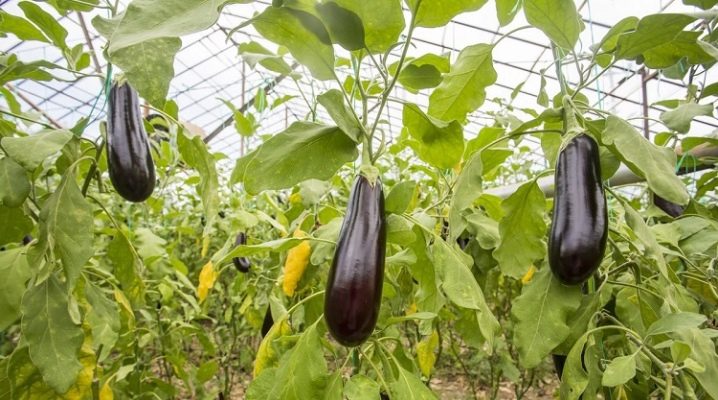
Eggplant is no longer exotic in our gardens, but some summer residents are afraid to approach this vegetable. It is believed that it is difficult to grow, possibly very demanding and capricious. But these doubts can be at least partially dispelled: eggplants can be both docile and predictable in terms of yield, if you get down to business wisely.
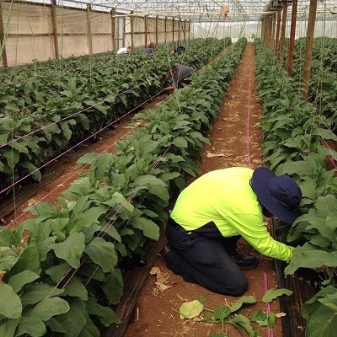
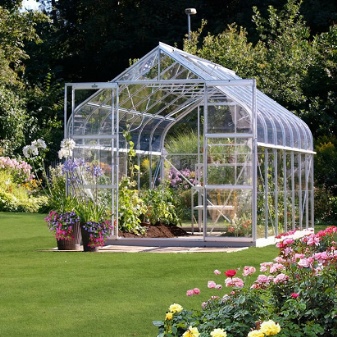
Terms and conditions
Planting eggplants in a greenhouse is the best option, because in such conditions it will be difficult to call a vegetable capricious... They need a temperature of + 25-28 ° C, as well as soil moisture at 80%. The plant is very thermophilic, and the moment of its transplantation into a greenhouse is not always obvious. Usually, early varieties are transplanted 40-45 days after seedlings emerge. If you are late, the seedlings can outgrow, and flower stalks can form there. But late-ripening varieties behave more predictably: as soon as the first shoots appear, you need to wait 2 months and then they can be transplanted. Seedlings with a height of about 20 cm, as well as with a well-developed crown of 6-8 true leaves, should go to a permanent place.
In the middle lane, eggplants are planted in a polycarbonate or film greenhouse in the first decade of May. And if you have to plant in the northern regions, the dates are shifted closer to June by 1-2 weeks. But you should always be guided by the weather. The soil should warm up to + 12 ° C, and night temperatures should be positive. If the greenhouse is made of polycarbonate, young plants will be saved from frost down to -3 degrees. But a significant cold snap is a threat to seedlings. However, you can make a shelter for the plant from a film stretched over arcs (agrofibre will also work). The beds can be watered overnight with warm water, and you can also leave buckets of water or even glowing coals in the greenhouse.
Thermal gas or electric guns are a modern way to maintain positive temperatures in the greenhouse.


Greenhouse preparation
The very organization of the greenhouse is a very crucial moment, because even, for example, a lack of space can prevent eggplants from developing normally. There must be a window in the greenhouse, since such a room needs to be ventilated without options. The structure should be practical, durable, solid and comfortable for the person who will take care of it. To prevent condensation in the greenhouse, you can use a special film, it is called that - anti-condensation. But it should be removed well, because if the temperature inside the greenhouse jumps over the + 28 ° C mark, the film is removed, otherwise the eggplants will suffocate.
The irrigation system in the greenhouse is also a mandatory thing, the organization of which must be competent. It can be drip, subsoil, sprinkler... How exactly to water depends on different parameters, even on the type of eggplant: some need waterlogged soil, some need strictly dryness.
But the heating to the greenhouse is connected only if the summer is very cold, or the summer residents are tuned in to almost year-round cultivation of this crop.
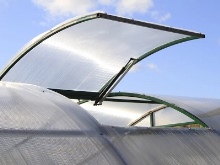


How to prepare the soil?
It, as expected, has been prepared since autumn. Plant residues of those crops that were in this place before are removed, the soil is spilled very well with water so that excess fertilizing can be washed off. Then the earth is disinfected from diseases with a solution of copper sulfate (2 tablespoons per 10 liters of hot water).And when the earth dries up, it is dug all over to the depth of the bayonet, loosening is also permissible. If the greenhouse remains without a roof for the winter, then the earth lumps do not need to be broken when digging, precipitation will accumulate in them, and the parasites will die. In the spring, you will only need to dig up warm loamy soil, but the rest is simply loosened.
Here's what else to do with the land.
- Eggplants really like organic matter, so half (or 3/4) of manure or compost humus is taken per square... The soil is also dusted with dolomite flour to reduce the acidity of the substrate. And flour also contains magnesium, which is very important for eggplants.
- It will be useful to put 0.5 buckets of low-lying brown peat in the soil, it perfectly retains moisture. To enhance the looseness of the soil, you can add sawdust (better lying down), about a glass, into it. A glass of ash and a tablespoon of potassium sulfate will also be useful.
- The calculation of fertilization is as follows: measure the footage of the garden bed, prepare the required amount of top dressing, scatter everything over the substrate and then dig it up thoroughly. But if the greenhouse is large, and there is little food for the soil, you can send fertilizer directly to the hole, and you can fully feed the eggplants during the growing season.
If diseases raged in the greenhouse last season, it is better not just to disinfect the ground, but simply to change the soil completely. And it is better to do this a few days before planting seedlings.
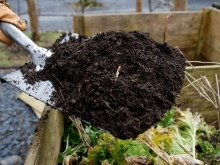


Landing schemes
First, the seedlings need to be prepared for the upcoming operation. A week and a half before disembarkation, the land is fed for the last time. A little earlier, the seedlings begin to harden. Here's how to do it. Reduce the temperature in the room at night to + 10 ... 15 exactly where the seedlings are stored. If this is not possible, they simply take out the seedlings to the balcony or veranda. They start with half an hour, and then for the whole day. It is better to plant eggplants in specially prepared holes: first, a mixture of soil, superphosphate and humus must be poured into them.
If you have to work with a difficult type of soil, sand or wood ash is added. A handful of onion skins will definitely not hurt, because its smell is an excellent repeller of Colorado beetles. If the weather is dry, the holes should be watered.
We will analyze according to what scheme to plant plants.
- To make the beds beautiful and the rows even, a rope is fixed along the rows - it will evenly mark the places of the holes.
- The scheme also depends on the type of culture, on the degree of growth of the eggplants, but the distance is selected at least 35 cm (the bushes are almost always very spreading).
- The distance between the rows is at least 60 cm, that is, it will be possible to plant no more than 5-6 bushes per 1 square.
- If the planting density is increased, the risk of eggplant morbidity can be increased, since the plants will simply not be sufficiently ventilated.
- Seedlings are planted both according to the standard ordinary scheme and in a checkerboard pattern - if the variety is tall, it is the second option that is welcome.
- Planting eggplants in one or two lines - depends primarily on the geometry of the greenhouse. If the greenhouse is wide, 3 m or more, usually a wide bed is equipped in the center, eggplants are planted in it in 2 rows, and narrow beds for other crops will fit along the walls.
- The distance from the rows to the walls of the greenhouse will depend only on the slope. If the walls of the greenhouse are vertical, 30 cm is enough, if inclined, 45-50 cm recede from the wall.
In polycarbonate greenhouses, as in homemade greenhouses, the same rules apply. A minimum of 0.5 m is left between the rows, and the aisles between the beds should be of such width that the owner can comfortably look after the plantings.
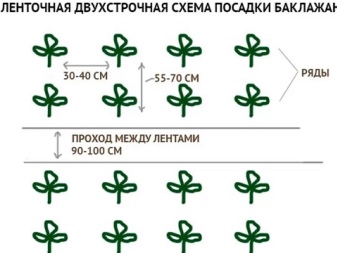
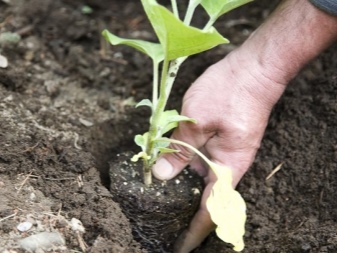
How to plant correctly?
There are two standard paths - seeds and seedlings.
Seeds
Seed preparation consists of several stages. First you need to choose - it's good if these are processed and packaged seeds. They will not need to be prepared additionally, they are already suitable for sowing. When choosing seeds, the varietal affiliation and compliance with the climatic conditions of the region are taken into account.Next, there will be calibration: the seeds are poured into a 3% saline solution - everything that floats to the surface is removed, because there is no embryo in the empty seeds. But those that have settled to the bottom must be collected, rinsed with clean water and dried, they will become free-flowing again.
Next, do the following with the seeds.
- Warm up... The seeds are put in a cloth bag, heated on a battery for about 25 minutes, but if the radiator is very hot, several gauze layers are laid under the bag. After warming up, the seeds are immersed in cold water for 3 minutes.
- Harden... Seeds moistened with water are placed in a cold place, after two days they will need to be dried.
- Disinfect... The seeds are simply soaked in a slightly pink one percent manganese solution for 10-15 minutes (no longer needed, otherwise the plant will burn).
- Stimulates growth. The seed must be soaked in a solution of "Kornevin" or "Epin". Both the concentration and the soaking time are indicated on the products.
The seeds can be planted in a common seedling container. The container is filled to the brim with the substrate, the soil is watered, and the earth settles. And this distance prevents soil leaching when it is necessary to further care for the seedlings. Then small grooves are made 1 cm deep, and there should be 3 cm between the rows. The seeds are laid out in rows, a distance of 1-2 cm is maintained between them. Soil is poured on top, the surface is moistened with a sprayer. The container is covered with polyethylene, which is removed as soon as shoots appear. It is also necessary to ventilate and moisturize the substrate from time to time. And as soon as the first true leaves appear on the seedlings, they are sent to separate containers.
Seedlings can be grown with and without a pick: if picking is implied, you need wooden boxes, plastic containers or trays... Soil is poured there, leveled and slightly compacted the surface. Individual containers are either plastic cups or peat pots. You can send one seed per pot, or you can send two, if both sprout, the weak will need to be cut off. The containers in the film are sent to a warm place.

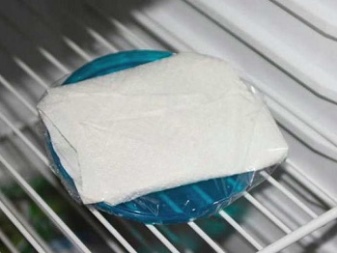
Seedlings
You can grow eggplants not in seed form, but buy ready-made seedlings. It is planted in a permanent place when the spring frosts will not return for sure. In the greenhouse, this will be mid-May, and cultivation on the street means landing in the first third of June. At the initial stage, after planting, you should cover the vegetables with a non-woven fabric, and shade on a sunny day. It is important that the eggplants are 60 days old for planting. The bushes should be visually complete, healthy, in height - about 25 cm. They should have a confidently developed root system and 8 leaves.
It is very convenient to grow seedlings in peat pots, which will then go to their place. Small holes are dug in the cultivated beds so that their depth is 2 cm higher than the peat pot itself. There will be 5-6 eggplant bushes on one meter. The hole is spilled with warm water, a pot is carefully inserted into it, covered with soil and a slide is made 2 cm above ground level. If the variety is medium-sized or tall, the plant is tied to supports so that leaves and shoots do not break off. Further, the eggplants just need to organize competent care.
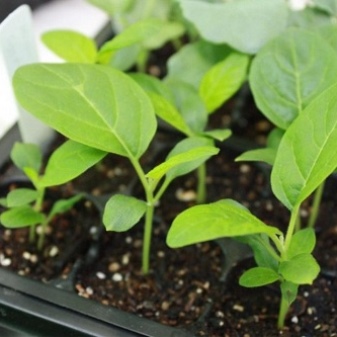
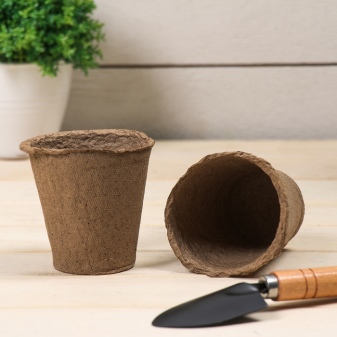
Follow-up care
It is necessary to take care of the plants after transplanting into the greenhouse according to the rules. And they are uncomplicated. For example, a convenient temperature for eggplants would be 25-27 degrees. Plants like dry air, but at the same time moist soil, that is, watering should be timely and sufficient.
Care rules:
- the first time the eggplants should be watered 5 days after transplanting to the street, and then - once every 7 days (often not necessary), the water should penetrate about 20 centimeters into the ground;
- at the time of fruiting, plants are watered twice a week, if it's hot, you can even more often;
- it is necessary to water the eggplants at the root, but the leaves must be dry;
- so that the moisture does not evaporate so quickly, the earth must be loosened by 3-5 centimeters in half a day after irrigation (this is also called "dry irrigation");
- you can water the plants only in the morning, then the substrate is mulched and the greenhouse must be ventilated, if not ventilated constantly, the risk of fungal attacks increases;
- at an excessive temperature (if you do not ventilate the greenhouse in a timely manner) aphids can sneak in there;
- the main thing is not to allow drafts to enter the greenhouse, which means that doors and / or transoms are allowed to be opened from one side;
- the plants are fed 3-5 times throughout the season, and the first feeding will be 2-2.5 weeks after planting;
- to optimize the growth of the culture, foliar dressing is used according to the leaves, it is repeated every half month;
- in case of insufficient flowering of the culture, eggplants are sprayed with boric acid (1 g per 5 l of water);
- it is necessary to tie the plants to the trellis, to do this quite delicately - the eggplants break easily;
- It is not necessary to pinch the plants, just removing the deformed fruits and yellowed leaves is enough.
This is not to say that it is very difficult to comply with all this. If you do not break the rules, you can grow an impressive crop that is good and healthy in any form.
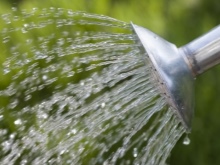
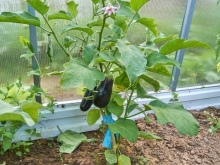
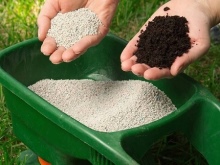












The comment was sent successfully.